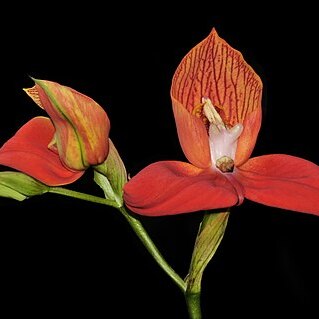Terrestrial herb with perennating tubers. Stems unbranched, leafy. Fertile shoots to 100 cm tall. Sterile shoots produced occasionally. Leaves radical, basal or cauline, linear to ovate, conduplicate to flat. Bracts usually green, ovate, acute or acuminate. Inflorescence terminal, racemose, with 1–numerous flowers. Flowers usually resupinate, 4–80 mm in diam., variously coloured. Sepals free; the dorsal sepal erect, galeiform, usually spurred; the lateral sepals spreading. Petals lanceolate to square, erect or reflexed, the apex curving over the rostellum or curving out of the galea. Labellum usually small and narrow, not lobed. Rostellum 3-lobed; anther 2-celled; viscidia usually separate; stigma pedicellate or sessile. Seed capsule cylindric, club-shaped or narrowly ellipsoid.
Dorsal sepal erect, galeate, rarely cucullate or dish-shaped, usually ovate, rarely oblong or spathulate, with a spur which is obsolete to 8 cm long, slender or rarely massive, rarely flattened or with a dorsal or ventral groove, horizontal, descending or ascending.
Leaves radical, basal or cauline, linear to ovate, soft to rigid, lax to imbricate, monomorphic to dimorphic, green at flowering time, occasionally hysteranthous, conduplicate to flat, grading into the floral bracts or sharply distinct from the floral bracts.
Petals lanceolate to square, erect or reflexed, acute or truncate, the apex curving over the anther or over the rostellum, or curved out of the galea, often with a complex plane shape.
Rostellum 3-lobed; lateral lobes erect, square or horn-like, flat or canaliculate, free or fused to the petals by a long keel; central lobe usually small, fleshy, rarely tall.
Stigma pedicellate or sessile, the surface flat, concave or convex, tripulvinate with the rear cushion often smaller than the lateral cushions.
Sterile shoots produced occasionally, to 15 cm long with several basal sheaths and several erect conduplicate acute leaves to 40 cm long.
Flowers not resupinate, resupinate or doubly resupinate, 4–80 mm in diameter, usually red or white, rarely blue or yellow or green.
Lateral sepals lanceolate to broadly ovate, rounded to acuminate, often keeled, patent, sometimes ascending or descending.
Anther 2-celled, horizontal, ascending or pendent; viscidia usually separate, borne on the lateral rostellum arms.
Lip usually lanceolate, rarely spathulate or broadly ovate, occasionally linear.
Bracts usually green, ovate, acute or acuminate, rarely dry and brown.
Inflorescence racemose with one to numerous flowers.
Terrestrial herb with perennating tubers.
Tubers testicular, rarely absent.
Fertile shoots to 100 cm tall.

